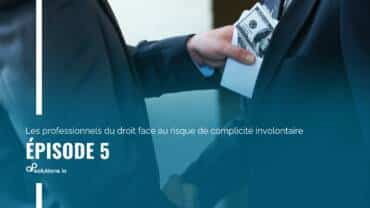Contents
THE LEGAL PROFESSION, A PRIME TARGET
STRICT OBLIGATIONS
HOW TO AVOID BECOMING AN UNWITTING ACCOMPLICE
HOW AP SOLUTIONS IO HELPS DETECT SUSPICIOUS TRANSACTIONS IN THIS SECTOR
Lawyers, notaries and other legal professionals don't just advise or defend their clients. They also play a strategic role in the fight against money laundering and the financing of terrorism. In fact, they wear two hats: on the one hand, their primary mission is to provide legal advice and support; on the other, they have a duty of vigilance to prevent legal financial circuits from being diverted for criminal purposes. Not always easy to reconcile. As a reminder, money laundering consists of reinjecting funds from illegal activities into the official economy, in order to disguise their origin. And it is precisely in certain high-stakes transactions, such as the purchase or sale of real estate, the creation of companies, fund management or the setting up of trusts, that the risks are concentrated for the legal professions.
THE LEGAL PROFESSION, A PRIME TARGET
Their expertise, their ability to hold customer funds directly and their position of trust can unfortunately be instrumentalized by criminal networks to legitimize illicit funds. The use of client accounts is a potential vulnerability, " as it can be perceived by criminals either as a means of melding illegally tainted funds into the general financial system, or as a means of layering these funds so as to disguise their source, as financial institutions pose fewer questions due to their perceived respectability and the legitimacy added by the involvement of members of the legal profession ", point out the FATF experts. Furthermore, real estate, both commercial and residential, accounts for a significant proportion of confiscated criminal assets, demonstrating that this is a significant point of vulnerability.
STRICT OBLIGATIONS
The role of the legal professions does not end with advice: it is strictly governed by international standards, in particular those of the FATF (Financial Action Task Force), and implemented in national legislation. In concrete terms, lawyers and notaries have three main obligations:
- Customer Due Diligence (CDD) Customer Due Diligence): identify their customers and verify the identity of Beneficial Owners.
- Know Your Customer (KYC): collect information on the nature and purpose of the business relationship, and ensure that transactions correspond to the customer's profile.
- Declaration of suspicion Suspicious transaction reporting: report to the competent authorities any suspicious transaction or fund whose origin or purpose appears doubtful.
It is this last obligation in particular that is causing tension, as it comes into direct collision with professional secrecy. But the rule is now clear: when it comes to money laundering and the financing of terrorism, reporting suspicions takes precedence.
However, there is an exception for lawyers: secrecy remains inviolable when they are providing legal advice or defending a client in court.
HOW TO AVOID BECOMING AN UNWITTING ACCOMPLICE
The legal professions operate in a sensitive environment: money laundering, terrorist financing... the risks are real, and sometimes involvement in suspicious transactions can be unintentional. So how can you avoid finding yourself at the heart of these practices? Our approach is based on four simple but essential principles:
1. Identify your customers and understand their activities.
2. Document every interaction to guarantee traceability and transparency.
3. Control risks through rigorous internal procedures.
4. Equip yourself with software solutions capable of detecting anomalies and alerting you in real time.
Identifying risks
Risks are not the same. They vary according to profession, business sector (real estate, securities management, management consulting), country of transaction, customer profile and transaction characteristics. A precise assessment, accompanied by a weighted classification, is essential to anticipate and prioritize risks.
Documenting risks
Once identified, risks must be formalized. This involves defining concrete scenarios, describing operating modes and suspicious behavior, and associating warning indicators with each type of risk. This documentation then becomes an operational tool for prevention and detection.
Managing risks
Controlling risks begins with a strict duty of vigilance. The FATF reminds us that "it is the responsibility of legal business leaders to foster and promote a culture of compliance". In practical terms, this means systematically reporting suspicious transactions via internal processes that are organized, auditable and regularly updated in line with changes in risks, activities and financial stakes.
Risk management also involves continuous monitoring using warning indicators: disproportionate volumes, unusual fluctuations, impossibility of physically meeting certain customers, unrealistic deadline requests, suspicion of tax fraud, frequent changes of contact or repetitive transfers of goods.
High-performance software solutions: allies for the legal profession
Most legal professions are not large organizations, but rather SMES or even VSEs. It's easy to imagine that the obligations incumbent upon them represent a considerable and time-consuming burden. The FATF points out that " the resources that small firms and legal entities can devote to AML-CFT are limited. For a number of legal professions, one and the same person may be responsible for front office, back office, reporting and management functions. " This is where specialized software solutions come in. They automate anomaly detection, centralize documentation and facilitate regulatory compliance, transforming a burdensome obligation into a genuine tool for operational efficiency.
HOW AP SOLUTIONS IO HELPS DETECT SUSPICIOUS TRANSACTIONS IN THIS SECTOR
AP Solution IO's solutions meet these principles, offering a complete platform for centralizing the management of all AML-CFT obligations:
- AP Scoring identifies, evaluates and quantifies risks, using powerful algorithms to analyze customers and their financial transactions, in order to establish a relevant score.
- AP Monitoring monitors and detects suspicious transactions in real time, with pre-configured scenarios, including those specific to the legal profession.
- AP Scan automates the entire process of detecting sensitive persons, significantly reducing false positives.
- AP Filter lists all at-risk countries and tracks international sanctions.

Protect your practice today: find out how AP Solutions IO simplifies AML-CFT compliance and helps you avoid the risk of inadvertent complicity.



